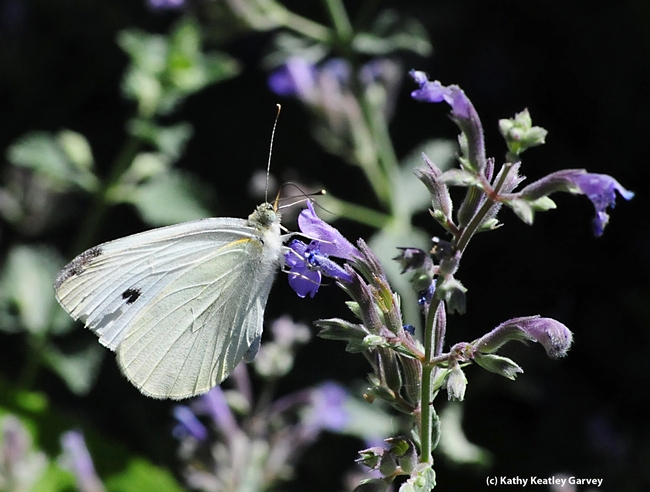Art Shapiro knows where to find the cabbage white butterflies (Pieris rapae).
No sooner had he announced his annual "Beer-for-a-Butterfly" Contest, then he found one. Actually, two.
Shapiro, distinguished professor of evolution and ecology at UC Davis, has sponsored the annual contest since 1972 to draw attention to the butterfly and its first flight. He's been monitoring butterflies for more than three decades.
He awards a pitcher of beer (or its cash equivalent) to the first person who collects the first cabbage white of the year in a three-county area: Yolo, Solano and Sacramento.
Tuesday, Jan. 1 2013 dawned rather cold. Not to worry. That afternoon, at precisely 1:18 p.m., Eureka! Shapiro collected a cabbage white near a railroad embankment in the Yolo County city of West Sacramento and spotted another at the same site.
“At 1:29 p.m., I saw a second rapae there but did not pursue it,” Shapiro said. “I figured that by the time I got near it, it would be somewhere else, so I let it be. The one that I took is unambiguously of the fall brood, based on phenotype--though it appears to have emerged today. Rapae was still flying here Dec. 17 and Dec. 24, so I was not entirely surprised to find it today.”
Of the contest, Shapiro said: “I do not close my beer contest if the fall brood slops over. So the contest is still open and will be until someone gets an actual example of the 2013 brood! Which, I suspect, will not be for 10-14 days...but I'll be looking, especially since the computer models are forecasting the next two weeks ‘dry.’
Shapiro related the details of his find. “Our family traditionally attends a New Year's Day party in Sacramento, regardless of the weather,” Shapiro said. “If the weather is good, I go in the field first--usually to North Sacramento, which is close to the party venue in Boulevard Park. But this year I went to West Sac instead, advisedly, because I was intensely curious whether rapae would indeed be out.”
“The wind was biting and made it feel colder than it was, but West Sac is wind-sheltered (the railroad embankment) and the south-facing slope was 50 degrees when I arrived at 11:45 a.m. It eventually topped out around 55-56 and actually felt warmer."
The cabbage white butterfly inhabits vacant lots, fields and gardens where its host plants, weedy mustards, grow. Shapiro saw some wild radish (Raphanus) in bloom, but no wild mustard (Brassica) in bloom. The first butterfly he saw was a Red Admiral (Vanessa atalanta) flying “from south to north, lickety-split.”
At 1:18 p.m. he spotted a rapae flying rather unsteadily parallel to the service road. “I lost it momentarily, then spotted it body-basking on a wild mustard leaf and caught it easily. It was a male of a typical late-autumn phenotype, heavy black pattern above, underside of hindwing bright yellow with a sprinkling of gray scales.”
“And it was incredibly fresh--the wings seemed soft, and one forewing got outside its corresponding hindwing in the net. This is something that happens occasionally with newly hatched bugs that are not fully ‘hardened’--I was afraid it might break off! I think it must have emerged today, and I got it on its maiden flight."
Shapiro, who usually wins his own contest, snagged the first cabbage white butterfly of 2012 at 11:50 a.m. on Sunday, Jan. 8 in West Sacramento. He caught the first cabbage white butterfly of 2011 at 1:21 p.m., Monday, Jan. 31 in Suisun City, Solano County.
Meanwhile, the contest is still under way, pending the declaration of a winner.
The rules state that butterfly must be collected outdoors in one of the three counties and delivered live to the office of the Department of Evolution and Ecology, 2320 Storer Hall, during work hours, 8 a.m. to 5 p.m., Monday through Friday. All entries must list the exact time, date and location of the capture and the collector’s name, address, phone number and/or email.
“The receptionist will certify that it is alive and refrigerate it,” Shapiro said. “If you collect it on a weekend or holiday, hold it your refrigerator but do not freeze it. A few days in the fridge will not harm it.”
Shapiro, who is in the field more than 200 days a year, has been defeated only three times since 1972. And all were his graduate students, whom he calls “my fiercest competitors.” Adam Porter defeated him in 1983; and Sherri Graves and Rick VanBuskirk each won in the late 1990s.
For more information on the beer-for-a-butterfly contest, contact Art Shapiro at amshapiro@ucdavis.edu, (530) 752-2176
Attached Images:
